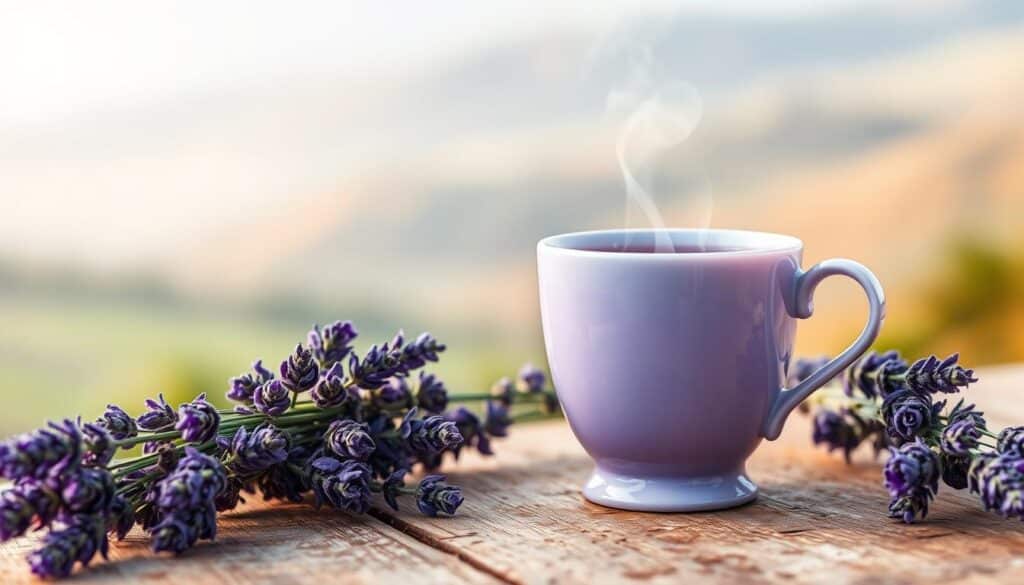Anúncios
Choose Headache-Relieving Foods for quick relief
Headaches can be debilitating, affecting daily life and productivity. While there are various treatments available, many people are turning to herbal teas as a natural way to find relief.
Anúncios
Herbal teas have been used for centuries to soothe and calm the body. Certain teas, such as peppermint and ginger, have properties that can help alleviate headache symptoms.
Key Takeaways
- Herbal teas offer a natural alternative for headache relief.
- Certain teas, like peppermint and ginger, have anti-inflammatory properties.
- Drinking herbal tea can be a calming and soothing experience.
- Herbal teas can be used in conjunction with other treatments.
- Consult a healthcare professional before using herbal teas as a treatment.

Natural Foods to Relieve Headaches
Understanding Headaches and Their Common Triggers
To manage headaches effectively, it’s essential to comprehend their various forms and triggers. Headaches can be debilitating, affecting daily life and productivity. By understanding the different types of headaches and what causes them, individuals can take the first step towards finding relief.
Anúncios
Different Types of Headaches
There are several types of headaches, including tension headaches, migraines, and cluster headaches. Tension headaches are often described as a band or a squeezing sensation around the head. Migraines are typically characterized by severe, throbbing pain, usually on one side of the head, and are often accompanied by nausea and sensitivity to light and sound.
Common Headache Triggers
Headache triggers can vary widely among individuals, but common culprits include stress, certain foods, and environmental factors. Stress is a significant trigger for tension headaches, while specific foods can trigger migraines. Keeping a headache diary can help identify personal triggers.
“Identifying and avoiding headache triggers can significantly reduce the frequency and severity of headaches.”
Why Natural Remedies Can Help
Natural remedies, particularly herbal teas, have been found to offer relief for headache sufferers. Teas such as peppermint, ginger, and chamomile possess anti-inflammatory, calming, and pain-relieving properties that can help alleviate headache symptoms. By incorporating these teas into their daily routine, individuals can potentially reduce their reliance on medication.
The Science Behind Natural Teas for Headache Relief
The effectiveness of natural teas in alleviating headaches is rooted in their complex biochemical composition. Herbal compounds found in these teas interact with our body’s pain pathways, offering relief from headache symptoms.
How Herbal Compounds Affect Pain Pathways
Herbal teas contain a variety of bioactive compounds that can influence pain perception. For instance, flavonoids and terpenes in teas like chamomile and lavender have been shown to have analgesic properties, helping to reduce pain sensitivity.
Anti-inflammatory Properties in Teas
Many herbal teas possess anti-inflammatory properties that can help alleviate headache symptoms. Teas like ginger and turmeric contain compounds that inhibit inflammatory pathways, potentially reducing the severity of headaches.
Relaxation and Stress Reduction Benefits
Stress is a common trigger for headaches, and stress reduction teas can play a crucial role in prevention. Herbal teas like lavender and chamomile promote relaxation, helping to mitigate stress-induced headache episodes.
The Role of Hydration in Headache Prevention
Hydration is crucial in headache prevention, as dehydration is a common headache trigger. Drinking herbal teas can contribute to daily fluid intake, helping to maintain proper hydration levels and potentially reducing headache frequency.
In conclusion, the science behind natural teas for headache relief is multifaceted, involving the interaction of herbal compounds with pain pathways, anti-inflammatory effects, stress reduction, and hydration. By understanding these mechanisms, individuals can make informed choices about using herbal teas as part of their headache management strategy.
Peppermint Tea: A Cooling Solution for Tension Headaches

For those suffering from tension headaches, peppermint tea offers a natural and soothing solution. The cooling effect of peppermint can help relax the muscles and improve blood flow, potentially easing headache symptoms.
Active Compounds in Peppermint
Peppermint tea contains several active compounds, most notably menthol and menthone, which contribute to its therapeutic properties. Menthol, in particular, is known for its analgesic and anti-inflammatory effects, making it beneficial for relieving pain associated with tension headaches.
How Peppermint Relieves Tension
The menthol in peppermint tea helps relax the muscles and improve circulation, which can become constricted during a tension headache. By promoting relaxation and reducing muscle tension, peppermint tea can provide relief from headache symptoms.
Preparation Tips for Maximum Benefit
To maximize the benefits of peppermint tea, it’s recommended to steep the leaves in boiling water for 5-7 minutes. Using high-quality peppermint leaves or tea bags can ensure a more potent brew. Additionally, combining peppermint with other herbs like chamomile can enhance its relaxing effects.
Recommended Brands and Products
Some popular brands for peppermint tea include Tazo, Celestial Seasonings, and Traditional Medicinals. When selecting a product, look for organic and fair-trade options to ensure quality and sustainability.
Ginger Tea: Fighting Inflammation and Nausea
For centuries, ginger tea has been revered for its medicinal properties, particularly in alleviating symptoms of inflammation and nausea. This natural remedy has been a staple in traditional medicine across various cultures, and its effectiveness in providing relief from headache symptoms, especially migraines, is well-documented.
Anti-inflammatory Properties
Ginger contains compounds like gingerol and shogaol, which have potent anti-inflammatory properties. These compounds work by inhibiting the production of pro-inflammatory cytokines, thereby reducing inflammation. The anti-inflammatory effects of ginger tea can help alleviate the severity of headaches and migraines, providing a natural and effective solution for those suffering from these conditions.
Benefits for Migraine-Related Nausea
Migraine-related nausea is a debilitating symptom that can significantly impact a person’s quality of life. Ginger tea has been shown to be effective in reducing nausea associated with migraines, thanks to its active compounds that help soothe the stomach and improve digestion. Drinking ginger tea at the onset of migraine symptoms can help mitigate nausea, making it easier to manage the condition.
Fresh vs. Dried Ginger Preparations
Both fresh and dried ginger can be used to prepare ginger tea, each offering its unique benefits. Fresh ginger provides a more vibrant flavor and potentially higher levels of active compounds, while dried ginger is more convenient and has a longer shelf life. Experimenting with both forms can help you find the preparation method that works best for you.
Adding Complementary Ingredients
To enhance the benefits of ginger tea, you can add complementary ingredients such as lemon, honey, or peppermint. These additions not only improve the flavor but also contribute their own medicinal properties. For instance, lemon adds vitamin C, while honey provides soothing effects on the throat.
“Combining ginger with other natural ingredients can create a powerful remedy for headache relief.”
Chamomile Tea: The Calming Headache Remedy
The calming properties of chamomile tea make it a valuable natural resource for alleviating headache symptoms and promoting relaxation. Chamomile tea, derived from the flowers of the chamomile plant, has been used for centuries as a natural remedy for various health issues, including headaches.
Stress-Reducing Properties
Chamomile tea is renowned for its stress-reducing properties. The apigenin, an antioxidant found in chamomile, binds to certain receptors in the brain, promoting relaxation and reducing stress levels. This can be particularly beneficial for individuals whose headaches are triggered or exacerbated by stress.
Sleep Improvement Benefits
Improving sleep quality is another significant benefit of chamomile tea. By consuming chamomile tea before bedtime, individuals can enjoy a more restful sleep, potentially reducing the frequency and severity of headaches. Quality sleep is essential for overall health, and chamomile tea can be a helpful addition to a bedtime routine.
Ideal Timing and Preparation
For maximum benefit, chamomile tea should be consumed regularly, ideally before bedtime to aid in sleep. To prepare, steep one heaping tablespoon of dried chamomile flowers in a cup of boiling water for 5-10 minutes. The tea can be enjoyed on its own or with a touch of honey for sweetness.
Choosing Quality Chamomile Products
When selecting chamomile tea, it’s crucial to choose high-quality products. Look for teas that are made from 100% chamomile flowers without any additives. Consider opting for organic products to minimize exposure to pesticides.
Lavender Tea: Aromatherapy in a Cup

Lavender tea offers a unique approach to headache relief by combining the benefits of aromatherapy with the soothing effects of herbal consumption. This dual-action remedy has been gaining attention for its potential to alleviate migraine symptoms and promote relaxation.
Dual Benefits: Aroma and Consumption
The essence of lavender tea lies in its ability to provide relief through both its aroma and consumption. When you inhale the steam from a cup of lavender tea, the aromatic compounds interact with your brain’s limbic system, potentially reducing stress and anxiety. Simultaneously, the active compounds in lavender, when consumed, may help in relaxing the body and reducing headache severity.
Key benefits of lavender tea include:
- Relaxation and stress reduction
- Potential migraine relief
- Improved sleep quality
Research on Lavender for Migraines
Research into the effects of lavender on migraines has shown promising results. Studies suggest that lavender’s calming properties can help in reducing the frequency and severity of migraine attacks. The exact mechanisms are still being studied, but it’s believed that lavender’s impact on the nervous system plays a crucial role.
Creating the Perfect Lavender Tea Ritual
To maximize the benefits of lavender tea, creating a soothing ritual can enhance the experience. This can involve brewing the tea in a peaceful environment, using calming music, or practicing deep breathing exercises while enjoying the tea.
Tips for a perfect lavender tea ritual:
- Choose a quiet, comfortable space
- Use high-quality lavender tea
- Combine with other calming practices like meditation or yoga
Combining with Other Calming Herbs
Lavender tea can be even more effective when combined with other calming herbs. Herbs like chamomile and lemon balm complement lavender’s soothing properties, potentially enhancing its headache-relieving effects.
By incorporating lavender tea into your daily routine, you may find a natural and effective way to manage headaches and improve your overall well-being.
Best Natural Teas for Headache Prevention and Treatment
Natural teas offer a holistic approach to headache relief, providing a range of benefits for prevention and treatment. By incorporating the right teas into your daily routine, you can significantly reduce the frequency and severity of headaches.
Daily Teas for Headache Prevention
For daily headache prevention, teas like peppermint and ginger are excellent choices. Peppermint tea, with its cooling effect, can help relax tense muscles, while ginger tea’s anti-inflammatory properties can reduce the likelihood of headache occurrence.
Other beneficial teas include chamomile and lavender, which promote relaxation and reduce stress, a common headache trigger.
Fast-Acting Teas for Acute Headaches
When it comes to fast relief from acute headaches, feverfew tea is particularly effective. Feverfew contains compounds that can help reduce inflammation and alleviate pain.
Willow bark tea is another option, as it contains salicin, a compound similar to aspirin, which can help reduce headache pain.
Seasonal Considerations for Tea Selection
The choice of tea can also be influenced by the season. For example, during colder months, ginger and spiced teas can be particularly comforting and help improve circulation.
In warmer months, peppermint and lemon balm teas can be refreshing and help keep you hydrated.
Creating a Tea Rotation for Maximum Benefit
To maximize the benefits of tea for headache prevention and treatment, consider creating a tea rotation. This involves switching between different teas to avoid developing a tolerance and to benefit from the unique properties of each tea.
| Tea Type | Benefits | Best For |
|---|---|---|
| Peppermint | Cooling effect, relaxes muscles | Tension headaches |
| Ginger | Anti-inflammatory properties | Migraine and inflammation-related headaches |
| Chamomile | Promotes relaxation, reduces stress | Stress-related headaches |
Feverfew and Willow Bark: Traditional Medicinal Teas
Feverfew and willow bark teas have been used for centuries in traditional medicine, offering natural relief for headache sufferers. These herbal remedies have been passed down through generations, with their efficacy now being supported by modern research.
Historical Use and Modern Research
Feverfew, known scientifically as Tanacetum parthenium, has been used since ancient times to treat various ailments, including headaches. Modern studies have validated its effectiveness in reducing migraine frequency and severity. A study published in the Neurology journal found that feverfew significantly reduced migraine symptoms in participants.
“Feverfew has been shown to be effective in reducing the frequency and severity of migraines, making it a valuable natural remedy for sufferers.”
Willow bark, containing salicin similar to aspirin, has been used for centuries to alleviate pain. Research supports its use for headache relief, with a study in Phytotherapy Research demonstrating its efficacy in reducing pain.
Proper Dosage and Preparation Methods
For feverfew tea, a typical dosage is 1-2 teaspoons of dried leaves per cup of boiling water, steeped for 5-7 minutes. Willow bark tea can be made with 1-2 teaspoons of dried bark per cup, steeped for 10-15 minutes.
| Herb | Dosage | Steeping Time |
|---|---|---|
| Feverfew | 1-2 tsp | 5-7 min |
| Willow Bark | 1-2 tsp | 10-15 min |
Important Safety Precautions
While generally safe, feverfew and willow bark teas can cause side effects. Feverfew may cause mouth ulcers, and willow bark can interact with blood thinners. Pregnant women and individuals with allergies should consult a healthcare provider before use.
Interactions with Medications
Both feverfew and willow bark can interact with certain medications. Feverfew may interact with anti-coagulants, while willow bark can enhance the effects of blood thinners and certain diabetes medications. It’s crucial to consult with a healthcare provider before adding these teas to your regimen, especially if you’re already taking medications.
Creating and Storing Your Headache-Relief Tea Collection
Understanding the basics of tea brewing and storage is key to harnessing the headache-relieving benefits of natural teas. A well-organized tea collection not only enhances the effectiveness of the teas but also makes the overall experience more enjoyable.
Essential Equipment for Tea Brewing
To start, you’ll need some essential equipment for brewing tea. A good quality tea infuser or strainer is crucial for releasing the flavors and active ingredients of the tea leaves. Additionally, using a glass or ceramic teapot is recommended as they don’t impart flavors to the tea, unlike metal pots.
Proper Storage Techniques
Proper storage is vital to maintain the freshness and potency of your teas. Store your teas in airtight containers away from light, heat, and moisture. This helps preserve the delicate compounds in the herbs. Labeling your containers can also help you quickly identify different teas.
Pre-Making Tea Blends for Convenience
Creating tea blends in advance can be very convenient. By mixing different herbs known for their headache-relieving properties, you can create a personalized blend that suits your needs. Store these blends in airtight containers and use them as needed.
Seasonal Adjustments to Your Collection
Adjusting your tea collection according to the seasons can enhance its effectiveness. For example, during colder months, you might prefer warming teas like ginger or cinnamon, while in warmer months, cooling teas like peppermint or chamomile might be more appealing.
By following these guidelines, you can create a headache-relief tea collection that is both effective and enjoyable to use.
When to Use Tea Remedies and When to Seek Medical Help
While natural teas can be an effective remedy for headaches, it’s crucial to understand when to use them and when to seek medical attention. Herbal teas have been used for centuries to alleviate headache symptoms, but they are not a replacement for medical care in all cases.
Recognizing Serious Headache Warning Signs
Some headaches can be indicative of more serious underlying conditions. Warning signs include sudden severe headache, headache with fever, confusion, or stiff neck, and headache accompanied by neurological symptoms such as weakness or numbness.
If you experience any of these symptoms, it’s essential to seek medical help immediately. A healthcare professional can diagnose the cause of your headache and provide appropriate treatment.
Integrating Tea Remedies with Conventional Treatment
Tea remedies can be used alongside conventional treatments for headaches. However, it’s crucial to inform your doctor about any herbal teas you’re consuming, as some may interact with medications.
- Peppermint tea can help relax muscles and improve blood flow.
- Ginger tea has anti-inflammatory properties that may help alleviate pain.
- Chamomile tea can promote relaxation and reduce stress.
Talking to Your Doctor About Herbal Remedies
When discussing your use of herbal teas with your doctor, be sure to mention the type of tea, the amount consumed, and how often you drink it. This information can help your doctor understand your treatment regimen and provide guidance on potential interactions.
| Herbal Tea | Potential Benefits | Possible Interactions |
|---|---|---|
| Peppermint | Relaxation, improved blood flow | Antacids, blood thinners |
| Ginger | Anti-inflammatory, nausea relief | Blood thinners, diabetes medications |
| Chamomile | Relaxation, sleep improvement | Blood thinners, sedatives |
Documenting Your Tea’s Effectiveness
Keeping a headache diary can help you track the effectiveness of your tea remedies. Record the type of tea consumed, the severity of your headache before and after consumption, and any other symptoms experienced.
By monitoring your tea’s effectiveness, you can make informed decisions about your headache management plan and adjust your approach as needed.
Conclusion: Embracing Natural Remedies for Headache Relief
As we’ve explored throughout this article, natural teas offer a promising approach to managing headaches. By understanding the different types of headaches and their triggers, you can better utilize herbal teas like peppermint, ginger, and chamomile to find relief.
Embracing herbal teas as a natural remedy can be a simple yet effective way to reduce headache frequency and severity. These teas not only provide a calming and soothing experience but also offer anti-inflammatory and pain-relieving properties.
By incorporating natural remedies like herbal teas into your daily routine, you can take a proactive approach to headache relief. Whether you’re looking to prevent headaches or alleviate symptoms, exploring the world of natural teas can be a valuable addition to your wellness journey.
FAQ
What are the best natural teas for headache relief?
How does peppermint tea help with tension headaches?
Can ginger tea help with migraine-related nausea?
How can I prepare chamomile tea for maximum benefit?
Is it safe to consume herbal teas with conventional headache medications?
How can I store my headache-relief tea collection?
Can I pre-make tea blends for convenience?
When should I seek medical help for my headaches?
Content created with the help of Artificial Intelligence.



